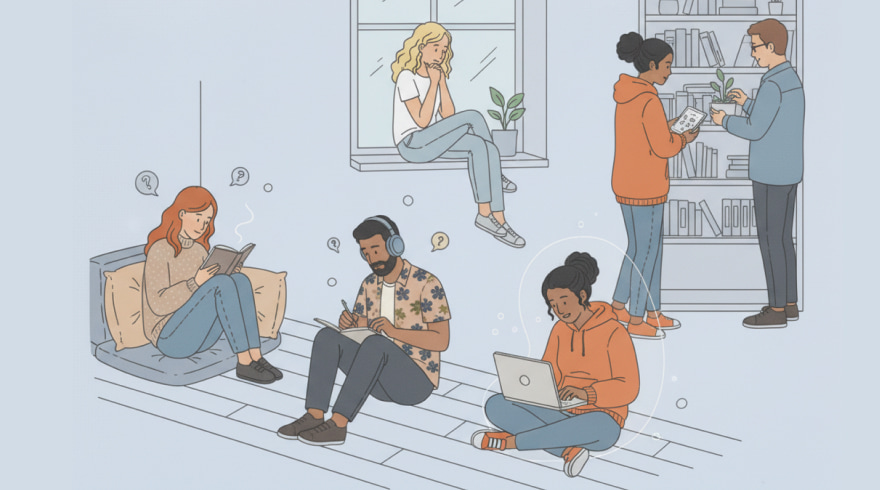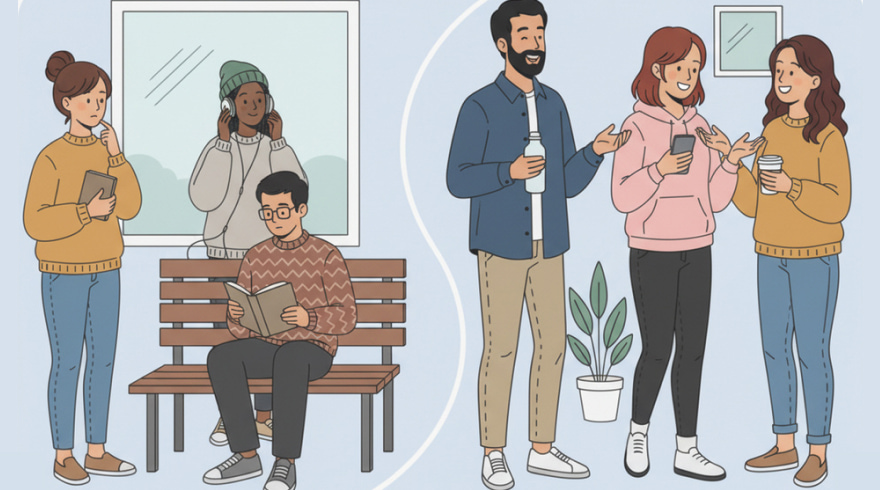Understanding the Four Introvert Profiles
- 27 October 2025

Why Recognizing Introversion Accurately Empowers Growth
Across workplaces, classrooms, and creative studios, quiet individuals often carry tremendous depth, careful judgment, and sustained focus. Many people thrive when they can think before speaking, plan before acting, and recharge away from the spotlight. By naming the nuances of inward focus, we gain language that honors reflective strength and invites productive collaboration.
Researchers and coaches increasingly map these patterns to clarify how behavior emerges in real contexts, and this clarity helps teams prevent misalignment. In that spirit, the phrase types of introverts captures a useful starting point for understanding distinct yet overlapping traits that show up across life domains. With shared vocabulary, managers avoid stereotyping, friends adapt plans with empathy, and individuals advocate for energy-protective routines.
When we look beyond labels, the core value appears in sustainable performance and healthier relationships. Many quiet professionals produce exceptional results when time, environment, and expectations fit their cognitive rhythm. In addition, seasoned mentors discuss focus, overstimulation, and boundaries to help people navigate feedback, meetings, and social obligations with less friction. The more accurately we describe inner processes, the more we can design conditions where concentration and imagination can persist without burnout.
Career pivots, leadership aspirations, and creative ambitions all benefit from a careful reading of one’s motivations. In applied coaching conversations, you’ll hear specialists unpack how attention, anxiety, planning, and social preferences intersect to produce day‑to‑day choices. Within those conversations, the category label introverted personality types appears as a scaffold for translating self‑insight into concrete routines and healthier commitments.
The Four Core Introvert Profiles Explained with Practical Examples
Psychologist Jonathan Cheek’s framework outlines four recurring patterns that explain how quieter people engage with the world in distinct ways. Each pattern brings gifts and potential friction points, and none is “better” or “worse” than the others when well understood. In applied settings, mentors often use these lenses to tailor communication, scheduling, and recovery time so strengths stay available under pressure.
Across research summaries and leadership programs, the framing of the 4 types of introverts acts like a map rather than a verdict, giving individuals language to request the right kind of support during sprints and slow cycles alike. With that map, people can fine‑tune how they work, recharge, and connect, without forcing themselves into loud environments that sap energy quickly.
Social Introvert
People in this profile prefer small circles and intimate gatherings, often choosing depth over breadth when it comes to relationships. They usually enjoy time with trusted friends, yet feel drained by large, unstructured crowds that demand rapid interaction. When teams respect planned social time and predictable formats, these individuals contribute warmth, humor, and loyalty in ways that stabilize culture.
Thinking Introvert
This pattern highlights rich inner life, self‑reflective habits, and strong imaginative capacity. Individuals often want space to mull ideas and refine frameworks before sharing drafts, which can make their eventual contributions unusually crisp. When leaders invite asynchronous feedback and provide clear problem statements, these thinkers deliver elegant analyses and creative breakthroughs.
Anxious Introvert
Here, sensitivity to social cues mixes with worry about performance or impression management. People may replay conversations, anticipate faux pas, or hesitate before entering unfamiliar situations, even when they desire connection. Supportive prep materials, clear agendas, and gentle facilitation can unlock calm participation without forcing constant spontaneity.
Restrained (Inhibited) Introvert
This profile moves deliberately and prefers to ramp up slowly rather than jump into high‑speed contexts. Morning routines, thoughtful transitions, and adequate lead time help these individuals perform reliably. When organizations respect pacing, you’ll see measured execution, careful risk evaluation, and consistent follow‑through.
| Profile | Core Drive | Strengths | Common Needs |
|---|---|---|---|
| Social | Depth in small groups | Loyalty, intimacy, steady rapport | Predictable gatherings, choice over crowd size |
| Thinking | Reflection and imagination | Insight, synthesis, creative problem‑solving | Uninterrupted focus, asynchronous input channels |
| Anxious | Safety and clarity | Preparation, detail sensitivity, empathy | Agendas, previews, supportive facilitation |
| Restrained | Deliberate pacing | Consistency, risk awareness, reliability | Lead time, structured transitions, quiet starts |
Over time, individuals may notice elements of more than one pattern, and that fluidity is normal in real life. In professional development workshops, facilitators stress that these lenses guide customization rather than lock anyone into rigid boxes. Within that spirit, the phrase four types of introverts functions as a conversational shorthand for a nuanced spectrum that honors complexity without sacrificing clarity.
Benefits of Knowing Your Profile for Work, Relationships, and Well-Being
Self‑awareness is a strategic asset, not a personality party trick, because it lets you allocate finite social and cognitive energy where it yields the best outcomes. When you understand your internal triggers, you can reduce friction and design routines that shield fragile focus from avoidable noise. In leadership contexts, this insight supports better negotiation around meeting formats, collaboration cadences, and deadline structures.
Career coaches use the term introvert personality types to connect inner preferences with observable workplace behavior in a constructive, nonjudgmental way. With that link in place, you can advocate for quiet hours, choose roles that exploit deep work, and time your most demanding tasks for your sharpest mental windows. The result is a more sustainable pace, fewer emotional energy crashes, and a more reliable sense of momentum.
Relationships benefit as well when friends and partners learn how you recharge and why overstimulation feels costly. Clear expectations about social plans prevent last‑minute pressure and reduce misunderstandings that come from mismatched energy needs. In everyday life, routines around sleep, exercise, and device boundaries protect attention, and those simple practices magnify your strengths without asking you to be someone else.
Language matters because it shapes permission, and permission unlocks better choices. When you name your patterns precisely, you gain confidence to say yes and no for the right reasons, not out of guilt or fear. In personal planning, many people find that recognizing their specific introvert types allows them to stack habits that compound into durable wellbeing over months and years.
Practical Strategies Tailored to Each Pattern
Every profile benefits from aligned rituals that channel quiet strengths into visible results. Social Introverts can block weekly coffee chats with one or two colleagues, avoiding noisy mixers while still nurturing trust. Thinking Introverts might adopt a capture‑and‑clarify flow to empty mental loops and convert ideas into shareable drafts without pressure to present prematurely.
Cross‑team collaboration often gets framed within personality types introvert extrovert discussions that explore how energy and environment interact during projects. Anxious Introverts thrive with thoughtful pre‑reads, stepwise agendas, and a designated ally in meetings who can invite contributions without spotlighting them unexpectedly. Restrained Introverts do well when leaders schedule ramp‑up time before sprints and buffer zones after intense deliverables to prevent cognitive whiplash.
Tools can boost signal and reduce noise when used intentionally rather than reactively. For example, asynchronous updates via docs and short videos protect deep work while still moving projects forward consistently. Teams can also rotate facilitation and deliberately limit simultaneous speakers to keep discussions coherent and inclusive.
Managers who plan with precision help quieter contributors demonstrate their best thinking in visible ways. In particular, team leads who map types of introverts and extroverts tend to distribute tasks more intelligently, which stabilizes tempo and improves handoffs. Over time, these practices reduce unnecessary conflict, because expectations match actual cognitive preferences rather than wishful thinking.
How to Pick or Build a Reliable Assessment
Online questionnaires can be fun, but rigor matters if you want decisions guided by trustworthy signals. Good assessments explain their model, define each construct, and share how results should and should not be used in practice. A sound tool also offers behavior‑based scenarios that feel realistic, avoiding vague adjectives that produce flattering but unhelpful profiles.
When evaluating options, people often search for a types of introverts quiz that balances nuance with clarity, so they can translate outcomes into daily habits immediately. Look for versions that include context‑specific prompts about meetings, recovery time, and creative cycles, because those details create advice you can act on this week. If the instrument shows how preferences shift under stress, you’ll have an even better guide for busy seasons.
Teams sometimes commission custom assessments for onboarding or leadership programs to align language and training materials. In that case, it helps to validate items with a pilot group and iterate until guidance feels precise across roles and seniority levels. For individuals who want something approachable, many reputable platforms now publish free versions accompanied by practical tip sheets.
Educators and coaches frequently recommend trying a concise 4 types of introverts quiz before deeper coaching, because it offers a quick snapshot that sparks productive reflection. After getting an initial read, you can confirm observations with journaling and feedback from trusted peers who see you in action. The best outcome is not a label, but a shared vocabulary that supports better boundaries, smarter scheduling, and kinder collaboration.
FAQ: Clear Answers to Common Questions
How is introversion different from shyness?
Introversion describes where you draw energy from and how you process stimulation, while shyness relates to fear or inhibition in social situations. Many quiet people feel comfortable around others when the context fits their preferences and pacing. In workshops, people sometimes ask what are the 4 types of introverts as a follow‑up, and that opens a broader conversation about specific patterns and use‑case guidance.
Can someone show traits from more than one profile?
Absolutely, and that flexibility is common across careers and life stages. Stress, role demands, and context can bring different capacities to the front, while core preferences remain fairly stable underneath. Coaches often encourage journaling to notice trends, because repeated patterns reveal needs that are easy to support once named.
Do these profiles change over time?
Fundamental tendencies usually stay steady, yet skills and coping strategies evolve as you practice new behaviors. You might learn to manage stimulation better, build social scripts, or design stronger boundaries around recovery time. Over years, people often report that values clarify while tactics become more elegant and less effortful.
How does this help at work?
Workplaces run on attention, and attention is finite, so fitting tasks to focus style improves output and reduces burnout. With better fit, you can schedule high‑stakes thinking for your sharpest hours and protect them from noise. Many organizations publish playbooks that explain collaboration norms, and those documents make meetings and handoffs cleaner.
Are all introverts alike in social settings?
No, because social comfort depends on goals, trust, group size, and sensory load rather than a single label. Some people love cozy gatherings and sustained conversations, while others prefer predictable routines and clearly structured roles. Educators often stress that acknowledging different types of introverts prevents blanket assumptions and makes inclusion practices more precise in everyday life.



